Vintage cakes aren’t just desserts; they’re edible pieces of art that take us back in time. With their intricate piping, pastel colors, and nostalgic designs, these cakes have made a major comeback in modern baking. But what really brings a vintage cake to life? The frosting.
A cake without the right frosting is like a painting without color—it lacks personality. The frosting isn’t just about taste; it’s about texture, consistency, and aesthetic appeal. Whether you’re making a classic heart cake for Valentine’s Day or a layered vintage wedding cake, choosing the perfect frosting is key.
Table of Contents
Understanding Heart Cakes: A Timeless Trend
What Is a Heart Cake?
Heart cakes are exactly what they sound like—cakes baked in the shape of a heart. Popular for romantic occasions like anniversaries, weddings, and Valentine’s Day, these cakes have a distinct vintage charm. Unlike regular round or square cakes, heart cakes require extra care when frosting to maintain their elegant curves.
Popular Occasions for Heart Cakes
- Valentine’s Day: The most common reason people bake heart cakes.
- Weddings: Some couples prefer a vintage heart-shaped wedding cake instead of a traditional tiered one.
- Anniversaries: A perfect way to celebrate love with a homemade, beautifully frosted cake.
- Birthdays: Vintage-themed parties often feature heart cakes with pastel frosting and intricate piping.
What Is the Best Frosting for Vintage Cakes?
Characteristics of the Perfect Vintage Cake Frosting
Vintage cakes require a frosting that is:
✔ Smooth: The texture should be creamy without being grainy.
✔ Stable: It needs to hold its shape for piping intricate designs.
✔ Not too sweet: Overly sugary frosting can overpower the cake’s flavor.
✔ Soft but firm: It should spread easily but set well once applied.
Traditional Frosting vs. Modern Frosting
- Traditional frostings like buttercream and royal icing were commonly used in vintage cakes due to their ability to hold detailed decorations.
- Modern frostings like whipped cream and fondant are often used today, but they don’t always provide the same old-fashioned charm.
Buttercream, Whipped Cream, or Fondant? A Comparison
| Frosting Type | Pros | Cons |
|---|---|---|
| Buttercream | Smooth, holds shape, rich flavor | Can be too sweet, melts in heat |
| Swiss Meringue Buttercream | Light texture, not overly sweet | More complex to make |
| Cream Cheese Frosting | Tangy, pairs well with vintage flavors | Softer texture, may not hold intricate piping |
| Royal Icing | Hardens well for fine details | Can be too firm for some cakes |
| Fondant | Smooth, polished look | Less flavorful, some find it too chewy |
Top 5 Frosting Recipes for Vintage Cakes
1. Classic American Buttercream
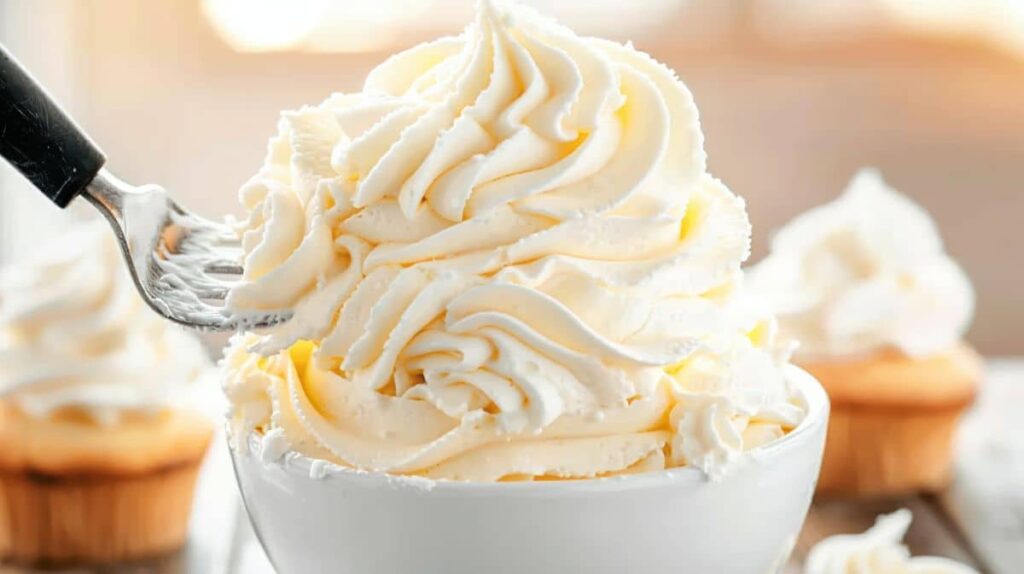
This is the go-to frosting for vintage cakes because of its simplicity and ability to hold shape.
Ingredients:
- 1 cup (230g) unsalted butter, softened
- 4 cups (480g) powdered sugar
- 2 teaspoons vanilla extract
- 3–4 tablespoons heavy cream
- A pinch of salt
Instructions:
- Beat the butter until creamy and smooth.
- Gradually add the powdered sugar, mixing well.
- Add vanilla extract and a pinch of salt.
- Slowly mix in heavy cream until the desired consistency is reached.
2. Swiss Meringue Buttercream
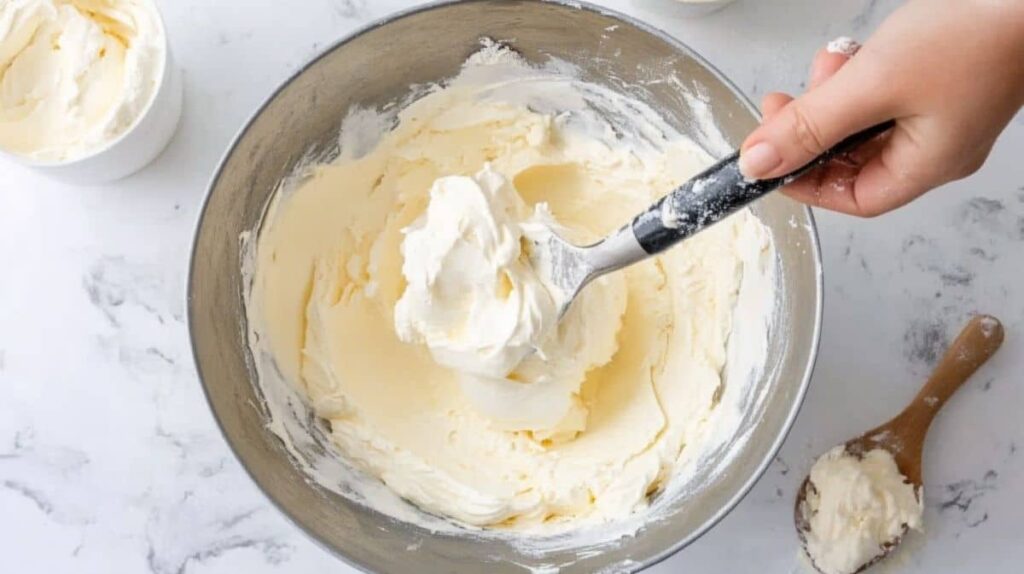
A less sweet, silkier alternative to American buttercream.
Ingredients:
- 5 large egg whites
- 1 ¼ cups (250g) granulated sugar
- 1 ½ cups (340g) unsalted butter, cubed
- 2 teaspoons vanilla extract
Instructions:
- Heat the egg whites and sugar over a double boiler, whisking constantly until the sugar dissolves.
- Remove from heat and whip the mixture until stiff peaks form.
- Slowly add butter, one cube at a time, until smooth.
- Mix in vanilla extract.
3. Cream Cheese Frosting
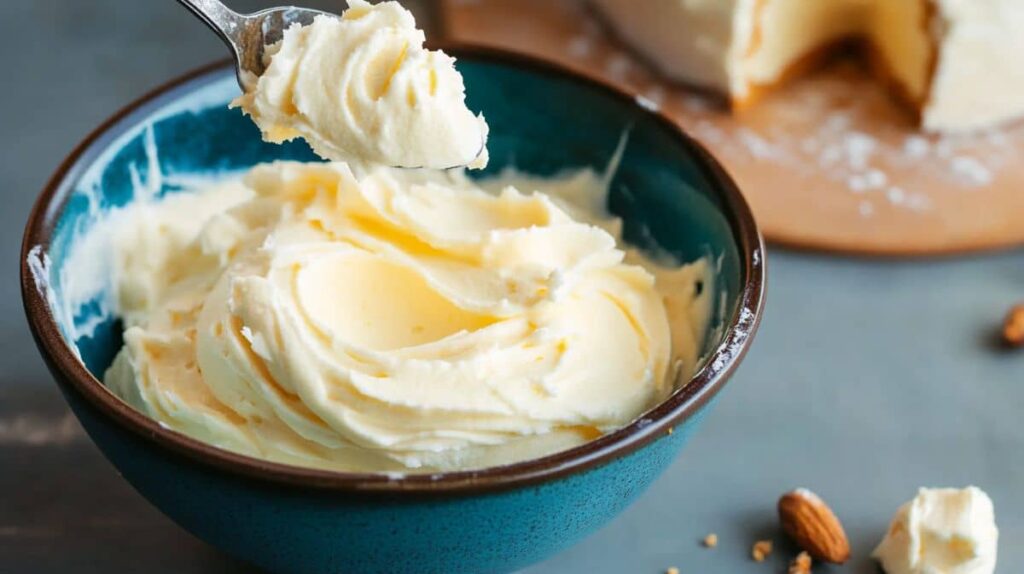
Perfect for vintage carrot cakes and red velvet cakes.
Ingredients:
- ½ cup (115g) unsalted butter, softened
- 8 oz (225g) cream cheese, softened
- 3 cups (360g) powdered sugar
- 1 teaspoon vanilla extract
Instructions:
- Beat the butter and cream cheese together until smooth.
- Gradually add powdered sugar and mix well.
- Stir in vanilla extract.
4. Royal Icing for Elegant Vintage Designs
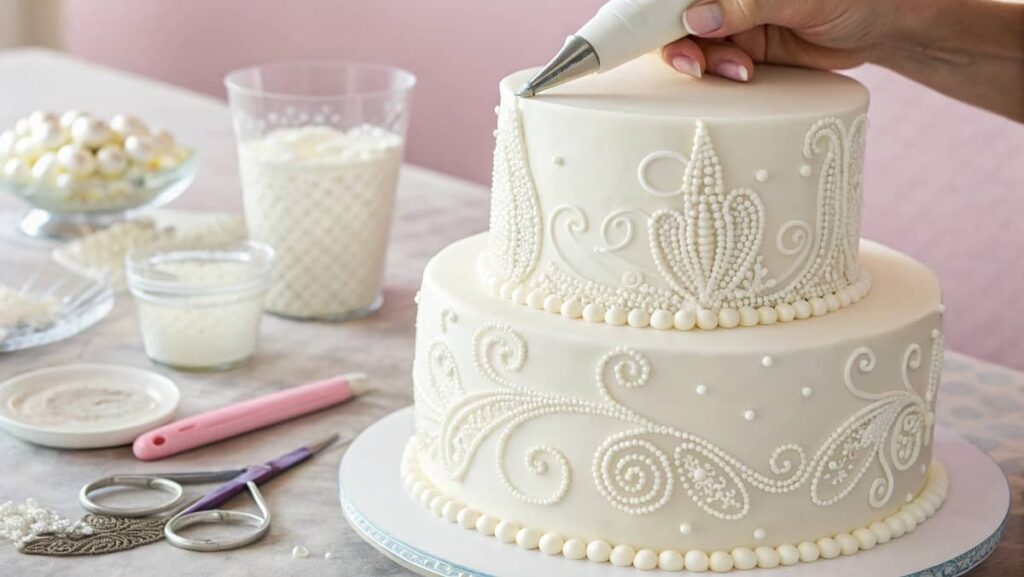
This icing is best for fine piping and intricate lacework.
Ingredients:
- 3 large egg whites
- 4 cups (480g) powdered sugar
- ½ teaspoon cream of tartar
Instructions:
- Beat egg whites until frothy.
- Add powdered sugar and cream of tartar.
- Whip until stiff and glossy.
5. Whipped Ganache for a Luxurious Finish
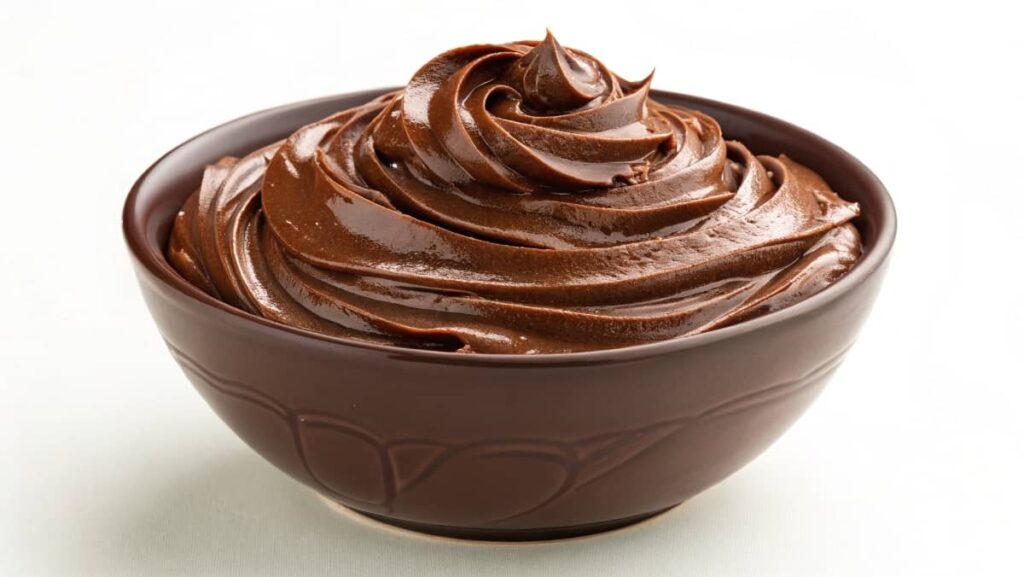
This rich chocolate frosting adds a touch of indulgence.
Ingredients:
- 8 oz (225g) dark chocolate, chopped
- 1 cup (240ml) heavy cream
Instructions:
- Heat the cream until just simmering, then pour over chopped chocolate.
- Let sit for 2 minutes, then stir until smooth.
- Allow to cool slightly, then whip until fluffy.
How to Achieve the Perfect Vintage Cake Aesthetic
Frosting Techniques for a Nostalgic Look
- Smooth finishes: Use an offset spatula to create a polished surface.
- Ruffled piping: A classic touch for vintage cakes.
- Rosettes and swirls: Achieved using star piping tips.
Piping, Ruffles, and Swirls: Decorating Tips
- Use a medium-stiff buttercream for best piping results.
- Hold the piping bag at a 45-degree angle for better control.
- Practice on parchment paper before piping directly onto the cake.
Choosing Colors and Textures for a Vintage Vibe
- Soft pastel shades like pink, mint, and lavender create a vintage feel.
- Textured edges with a spatula add depth and charm.
- Gold or pearl accents enhance the antique aesthetic.
Common Problems When Frosting Vintage Cakes (and How to Fix Them)
Problem 1: Frosting Is Too Runny
A runny frosting can ruin the entire look of a vintage cake, making it impossible to hold intricate details. This usually happens when too much liquid is added, or the butter is too soft.
How to Fix It:
- Add more powdered sugar to thicken the consistency.
- If using buttercream, refrigerate it for 15–20 minutes to firm it up.
- For meringue-based frostings, continue whipping until the texture becomes stable.
Problem 2: Frosting Won’t Stick to the Cake
If your frosting slides off or refuses to adhere, the cake might be too greasy or crumbly.
How to Fix It:
- Lightly coat the cake with a crumb coat (a thin layer of frosting) before applying the final layer.
- If the cake is too dry, brush it with simple syrup before frosting.
- Use a stiffer frosting, such as Swiss meringue buttercream, for better adherence.
Problem 3: Buttercream Is Too Sweet
Some traditional buttercream recipes can be overwhelmingly sweet, which may not suit every palate.
How to Fix It:
- Add a pinch of salt to balance the sweetness.
- Mix in a small amount of lemon juice or cream cheese for a slight tang.
- Opt for Swiss or Italian meringue buttercream, which has a less sugary taste.
Problem 4: Achieving Sharp Edges and Defined Designs
Vintage cakes often have precise piping and clean edges, but achieving this look can be challenging.
How to Fix It:
- Use a bench scraper to smooth the frosting for sharp edges.
- Chill the cake after the crumb coat, then apply the final layer.
- For intricate piping, ensure the frosting is at the right consistency—not too stiff or too soft.
Pro Tips for Making the Best Vintage Cake Frosting
The Best Ingredients for a Smooth and Tasty Frosting
Using high-quality ingredients makes a noticeable difference in both taste and texture.
- Butter: Always use unsalted butter for better control over the flavor.
- Powdered Sugar: Sift it before use to prevent lumps.
- Heavy Cream: Helps achieve a creamy, smooth consistency.
- Vanilla Extract: Opt for pure vanilla instead of artificial flavoring.
- Egg Whites (for meringue-based frostings): Ensure they are fresh for the best results.
How to Store and Preserve Frosting
Proper storage keeps frosting fresh and easy to use for future cakes.
| Storage Method | Duration | Notes |
|---|---|---|
| Room Temperature | Up to 2 days | Best for buttercream (if no dairy is added). |
| Refrigerator | Up to 1 week | Store in an airtight container. Rewhip before use. |
| Freezer | Up to 3 months | Thaw in the fridge and mix before using. |
Making Frosting in Advance: Pros and Cons
| Advantage | Disadvantage |
|---|---|
| Saves time for large cake projects | Some frostings lose texture when refrigerated |
| Allows flavors to develop | Needs to be rewhipped before use |
| Prevents last-minute baking stress | Can absorb fridge odors if not stored properly |
FAQs About Vintage Cake Frosting
What type of icing should be used for a vintage cake?
The best icing for a vintage cake depends on the design and texture you want to achieve. Traditional vintage cakes typically use American buttercream, Swiss meringue buttercream, or royal icing for their smooth consistency and ability to hold intricate piping. If you prefer a softer, more rustic look, whipped cream frosting or cream cheese frosting can also be used.
What frosting do professionals use for cakes?
Professional bakers often use Swiss meringue buttercream or Italian meringue buttercream because they are less sweet, have a silky texture, and hold their shape well for intricate designs. For structured, highly detailed cakes, fondant is also a popular choice, as it creates a smooth, polished finish.
What icing is used on fancy cakes?
Fancy cakes, such as wedding cakes and luxury-tiered cakes, often use fondant, royal icing, or Swiss meringue buttercream. Fondant provides a sleek, flawless surface, while royal icing is perfect for delicate lacework and decorative piping. Swiss meringue buttercream is preferred for a smooth, professional finish with a lighter taste.
How do you frost a rustic cake?
To achieve a rustic cake look, use semi-naked frosting or a textured buttercream finish. Follow these steps:
- Apply a thin crumb coat – Spread a small amount of buttercream over the cake to seal in crumbs.
- Use an offset spatula – Spread the frosting with light strokes, leaving some areas semi-transparent for a naked cake effect.
- Create texture – Use a spoon or spatula to add ridges and uneven patterns for a natural, rustic appearance.
- Decorate with fresh elements – Rustic cakes often feature fresh flowers, berries, or a dusting of powdered sugar for an organic feel.
This technique works best with American buttercream, Swiss meringue buttercream, or whipped cream frosting, as they allow for easy spreading and texturing.
Related Articles: More on Vintage Cakes and Frosting
If you’re looking for more inspiration on heart-shaped cakes and vintage cake decorating, check out these helpful guides:
- How Many Slices in a 10-Inch Heart Cake? – Learn how to portion a heart-shaped cake perfectly for any occasion.
- Red Velvet Heart Cake: Dairy Queen Style – Get inspired by this classic heart-shaped cake with a vintage twist.
- How to Make a Heart Cake Without a Pan – A creative guide to achieving the perfect heart cake shape without special bakeware.
These articles will give you more insights into heart cakes, portioning, and styling your vintage desserts effortlessly.
Conclusion: Bringing Vintage Cakes to Life
Final Thoughts on Frosting and Decoration
Frosting is the heart of any vintage cake, transforming a simple sponge into a nostalgic masterpiece. Whether you opt for classic buttercream, silky Swiss meringue, or elegant royal icing, the key is choosing a frosting that complements both the flavor and aesthetic of your cake. Achieving the perfect consistency, mastering piping techniques, and selecting the right colors are all essential steps in creating an authentic vintage look.
Experimenting with Flavors and Styles
One of the joys of baking is the freedom to experiment. While traditional vanilla and chocolate frostings remain timeless, don’t be afraid to incorporate unique flavors like lavender, rose, or citrus to enhance your vintage cakes. Play with textures, mix different piping styles, and find your signature touch. Baking is both an art and a science, and with practice, anyone can create stunning, beautifully frosted vintage cakes that not only look good but taste amazing.
Summary Table: Choosing the Best Frosting for Your Vintage Cake
| Frosting Type | Best For | Pros | Cons |
|---|---|---|---|
| Buttercream | Most vintage cakes | Smooth, easy to work with, rich flavor | Can be too sweet, melts in heat |
| Swiss Meringue Buttercream | Elegant, smooth finishes | Less sweet, holds shape well | More time-consuming to prepare |
| Cream Cheese Frosting | Carrot cakes, red velvet cakes | Tangy, creamy, complements bold flavors | Softer texture, may not hold intricate designs |
| Royal Icing | Intricate piping, lacework | Hardens well, perfect for details | Can be too firm for covering entire cakes |
| Whipped Ganache | Chocolate lovers, luxurious cakes | Rich, smooth, and decadent | Requires careful temperature control |
Final Tip: Enjoy the Process
Baking vintage cakes should be fun, not stressful. Every baker, whether beginner or experienced, will encounter challenges, but the beauty of baking is in learning and improving. Enjoy experimenting with different frostings, decorating techniques, and flavors until you create a vintage cake that’s both visually stunning and irresistibly delicious.
This concludes the full article. Now you’re ready to make the best frosting for vintage cakes and bring timeless elegance to your baking.

